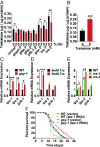Metabolic shift from glycogen to trehalose promotes lifespan and healthspan in Caenorhabditis elegans
- PMID: 29511104
- PMCID: PMC5866546
- DOI: 10.1073/pnas.1714178115
Metabolic shift from glycogen to trehalose promotes lifespan and healthspan in Caenorhabditis elegans
Abstract
As Western diets continue to include an ever-increasing amount of sugar, there has been a rise in obesity and type 2 diabetes. To avoid metabolic diseases, the body must maintain proper metabolism, even on a high-sugar diet. In both humans and Caenorhabditis elegans, excess sugar (glucose) is stored as glycogen. Here, we find that animals increased stored glycogen as they aged, whereas even young adult animals had increased stored glycogen on a high-sugar diet. Decreasing the amount of glycogen storage by modulating the C. elegans glycogen synthase, gsy-1, a key enzyme in glycogen synthesis, can extend lifespan, prolong healthspan, and limit the detrimental effects of a high-sugar diet. Importantly, limiting glycogen storage leads to a metabolic shift whereby glucose is now stored as trehalose. Two additional means to increase trehalose show similar longevity extension. Increased trehalose is entirely dependent on a functional FOXO transcription factor DAF-16 and autophagy to promote lifespan and healthspan extension. Our results reveal that when glucose is stored as glycogen, it is detrimental, whereas, when stored as trehalose, animals live a longer, healthier life if DAF-16 is functional. Taken together, these results demonstrate that trehalose modulation may be an avenue for combatting high-sugar-diet pathology.
Keywords: daf-16; glycogen; gsy-1; lifespan; trehalose.
Conflict of interest statement
The authors declare no conflict of interest.
Figures






Similar articles
-
DAF-16/FoxO in Caenorhabditis elegans and Its Role in Metabolic Remodeling.Cells. 2020 Jan 2;9(1):109. doi: 10.3390/cells9010109. Cells. 2020. PMID: 31906434 Free PMC article. Review.
-
Increased Protein Stability and Decreased Protein Turnover in the Caenorhabditis elegans Ins/IGF-1 daf-2 Mutant.J Gerontol A Biol Sci Med Sci. 2016 Dec;71(12):1553-1559. doi: 10.1093/gerona/glv221. Epub 2016 Feb 10. J Gerontol A Biol Sci Med Sci. 2016. PMID: 26865495 Free PMC article.
-
Accumulation of Glycogen and Upregulation of LEA-1 in C. elegans daf-2(e1370) Support Stress Resistance, Not Longevity.Cells. 2022 Jan 12;11(2):245. doi: 10.3390/cells11020245. Cells. 2022. PMID: 35053361 Free PMC article.
-
Glycogen controls Caenorhabditis elegans lifespan and resistance to oxidative stress.Nat Commun. 2017 Jun 19;8:15868. doi: 10.1038/ncomms15868. Nat Commun. 2017. PMID: 28627510 Free PMC article.
-
Glycogen at the Crossroad of Stress Resistance, Energy Maintenance, and Pathophysiology of Aging.Bioessays. 2018 Sep;40(9):e1800033. doi: 10.1002/bies.201800033. Epub 2018 Jun 13. Bioessays. 2018. PMID: 29897131 Review.
Cited by
-
Mitochondrial protein import determines lifespan through metabolic reprogramming and de novo serine biosynthesis.Nat Commun. 2022 Feb 3;13(1):651. doi: 10.1038/s41467-022-28272-1. Nat Commun. 2022. PMID: 35115503 Free PMC article.
-
A metabolic switch regulates the transition between growth and diapause in C. elegans.BMC Biol. 2020 Mar 18;18(1):31. doi: 10.1186/s12915-020-0760-3. BMC Biol. 2020. PMID: 32188449 Free PMC article.
-
Pasteurized Akkermansia muciniphila Reduces Fat Accumulation via nhr-49-Mediated Nuclear Hormone Signaling Pathway in Caenorhabditis elegans.Molecules. 2022 Sep 20;27(19):6159. doi: 10.3390/molecules27196159. Molecules. 2022. PMID: 36234692 Free PMC article.
-
The conserved histone chaperone LIN-53 is required for normal lifespan and maintenance of muscle integrity in Caenorhabditis elegans.Aging Cell. 2019 Dec;18(6):e13012. doi: 10.1111/acel.13012. Epub 2019 Aug 9. Aging Cell. 2019. PMID: 31397537 Free PMC article.
-
Knock-down of odr-3 and ife-2 additively extends lifespan and healthspan in C. elegans.Aging (Albany NY). 2021 Sep 9;13(17):21040-21065. doi: 10.18632/aging.203518. Epub 2021 Sep 9. Aging (Albany NY). 2021. PMID: 34506301 Free PMC article.
References
-
- Zuker CS. Food for the brain. Cell. 2015;161:9–11. - PubMed
Publication types
MeSH terms
Substances
Grants and funding
LinkOut - more resources
Full Text Sources
Other Literature Sources
Research Materials
Miscellaneous

